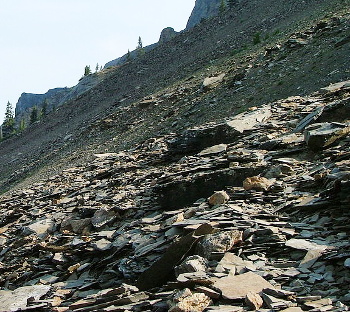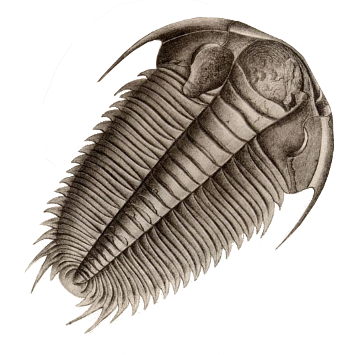Trilobite Sex
March 13, 2017
Just as people have a difficult time understanding those who speak a
foreign language, the
general public has a hard time understanding
science, since
scientists have their own
language. An example of this, as devised by
science fiction author and
biochemist,
Isaac Asimov (1920-1992), is how people interpret the word,
unionized. Non-scientists will invariably think of a
trade union, while scientists will think of a
neutral atom (not
ionized).
When I left
academia and joined a
corporate research laboratory, I found that many of my new
colleagues had adopted some of the language of the corporate
business administrators with whom we shared our
campus. This was the time before the
Six Sigma management fad and its concurrent expressions like, "Work smarter, not harder," but the first memorable
proverb of the modern age I heard was "
No amount of careful planning can beat pure luck."
Indeed, many
scientific discoveries were accidental, a
phenomenon commonly known as
seredipity.
Wikipedia has a
short page listing a few historical examples. One of my favorites as a
materials scientist is the supposed discovery of
stainless steel by
English metallurgist,
Harry Brearley (1871-1948).

Photo of English metallurgist, Harry Brearley (1871-1948), from a monument at the former Brown Firth Research Laboratories, Sheffield, England.
Brearley discovered stainless steel, supposedly by accident.
(Wikimedia Commons image by David Morris, modified for artistic effect.)
Brearley noticed a piece of
non-rusted metal in a pile of
alloy samples he had prepared for
erosion resistance testing. This
chromium-containing sample marked the
invention of stainless steel.
Biologists have a similar example of
Alexander Fleming's (1881-1955) discovery of
penicillin.
Paleontologists are more at the mercy of serendipity than any other group of scientists. These
fossil hunters can only study what they find in the ground, as good an example of a "
needle in a haystack"
motif as any. Fortunately, they're guided in where to look by observations of
geological strata conducted over the
centuries. In this way they can pinpoint the
layers of earth corresponding to a particular
epoch.

The trilobite beds at Mount Stephen, British Columbia, a part of the Burgess Shale Formation.
The Burgess shale contains many Middle Cambrian period fossils of organisms that existed half a billion years ago.
(Wikimedia Commons image.)
The so-called
Cambrian explosion, starting about 541 million years ago, was a time of rapid
diversification of
organisms from simple
cell colonies to large
animals, including
trilobites. The
Burgess Shale Formation in
British Columbia is important to
paleontology, since the
shale preserved
fossils of soft body parts, such as
legs,
gills, and
antennae, of these animals.
Trilobites are
marine arthropods in the
subphylum Trilobitomorpha. They are
invertebrates having an
exoskeleton, a segmented body, and
jointed appendages. The name, "trilobite," derives from the
Greek words τρι- (tri-, "three") and λοβος (lobos, "lobe"), and they resemble the
horseshoe crab, an arthropod of the subphylum
Merostomata. Trilobite fossils are found worldwide, and several thousand trilobite
species are known. A trilobite even made an appearance in the
first Godzilla movie (Godzilla, 1954,
Ishiro Honda,
Director).[1-2]

Trilobite illustration (Plate 3, vol. I, suppl. II) from the 1852 Système silurien du centre de la Bohême by Joachim Barrande (1799-1883).
Barrande was a French paleontologist who published this landmark study of trilobites of the Cambrian, Ordovician and Silurian periods of Bohemia.
(Portion of a Wikimedia Commons image.)
One interesting feature of trilobites that's been discovered from their fossils is the nature of the
lenses of their
eyes. As I wrote in a
previous article (The Trilobite Eye, May 3, 2013), trilobites had
compound eyes that resembled
insect eyes. The lenses were an array of closely-packed hexagonal
facets formed from
calcite.[3] Although calcite is
transparent, it's optically
birefringent; that is,
non-polarized light entering a birefringent
crystal is split into two
beams, one of which (the "ordinary" beam) follows the
usual refraction laws, with the other ("extraordinary" beam) going off at a different
angle.
For 600
nm light, which is roughly in the middle of the
visible spectrum, calcite has an ordinary
refractive index no of 1.486, and an extraordinary index
ne of 1.660, so the beam paths will diverge when the incident beam is not along the
optical axis of the crystal. This meant that trilobites had good forward vision, but poor
peripheral vision, and this deficit was probably mitigated by the compound nature of the lens. Since a trilobites's existence involved just
eating things in front of it and avoiding large
predators that would be loom large in any peripheral vision, the calcite lenses were adequate, as evidenced by the fact that trilobites existed for 270 million years.
While
female horseshoe crabs are abundant
egg layers, from an
ovarian network within their
head, there has been no fossil evidence of trilobite eggs or their
genitalia. This is not surprising, since the preservation of soft body structures in the fossil record is rare. Now, a team of scientists from
Western Illinois University (Macomb, Illinois), and
Vanderbilt University (Nashville, Tennessee) has published images of fossilized eggs of the trilobite species,
Triarthrus eatoni, from the
Lorraine Group in
Upstate New York.[4-5]
This remarkable preservation was achieved since the exoskeletons were replaced with
pyrite.[4-5] The 0.2
millimeter eggs were found to be
spherical and
ellipsoidal in shape, and they were clustered
ventrally at the head. The small size of the eggs suggests that trilobites may have hatched without a
protaspis shield, the precursor to the articulated shell.[4]

Egg images of pyritized trilobite specimens (Triarthrus eatoni) from the Ordovician Whetstone Gulf Formation of the Lorraine Group in Upstate New York. (Portion of an image by Thomas A. Hegna et al., © 2017, the Geological Society of America.)
The location of the eggs is like that of horseshoe crabs, which release their unfertilized eggs from the ovarian network within their head.[4-5] Trilobites likely released either eggs or
sperm through a
genital pore likely located near the posterior boundary of the head, and they spawned through
external fertilization.[4-5]
References:
- Godzilla (1954, Ishiro Honda, Director), on the Internet Movie Database.
- Trilobite Discovery (1954), YouTube video by Spike Genalo, May 26, 2011.
- Vernon L.Williams, "Evolution and the Calcite Eye Lens," arXiv, April 3, 2013.
- Thomas A. Hegna, Markus J. Martin, and Simon A.F. Darroch, "Pyritized in situ trilobite eggs from the Ordovician of New York (Lorraine Group): Implications for trilobite reproductive biology," Geology, vol. 45, no. 3 (March, 2017), pp. 199-202, doi: 10.1130/G38773.1.
- Trilobite Eggs in New York, Geological Society of America Press Release No. 17-05, February 23, 2017.
Permanent Link to this article
Linked Keywords: Foreign language; general public; science; scientist; language; science fiction; author; biochemistry; biochemist; Isaac Asimov (1920-1992); trade union; neutral particle; atom; ionization; ionized; academia; corporation; corporate; research; laboratory; colleague; business administrator; campus; Six Sigma; management fad; proverbial phrase; proverb; No amount of careful planning can beat pure luck; scientific discovery; phenomenon; seredipity; Wikipedia; list of discoveries influenced by chance circumstances; materials science; materials scientist; stainless steel; English; metallurgy; metallurgist; Harry Brearley (1871-1948); monument; Brown Firth Research Laboratories; Sheffield, England; stainless steel; Wikimedia Commons; rust; rusted; alloy; sample; erosion resistance; chromium; invention; biologist; Alexander Fleming (1881-1955); penicillin; paleontology; paleontologist; fossil; needle in a haystack; motif; stratum; geological strata; century; centuries; layers of earth; epoch; trilobite bed; Mount Stephen; British Columbia; Burgess Shale Formation; Middle Cambrian period; organism; Cambrian explosion; genetic divergence; diversification; cell; colony; colonies; animal; trilobite; shale; leg; gill; antenna; marine; arthropod; subphylum; Trilobitomorpha; invertebrate; exoskeleton; joint; appendage; Greek language; Greek word; horseshoe crab; Merostomata; species; first Godzilla movie; Ishiro Honda; film director; Joachim Barrande (1799-1883); French; Ordovician; Silurian; Bohemia; lens; eye; compound eye; insect eye; facet; calcite; transparency; transparent; birefringence; birefringent; polarization; polarized light; crystal; light beam; Snell's law; angle; nanometer; nm; visible spectrum; refractive index; optical axis; peripheral vision; eat; predation; predator; female; egg; egg-laying reproduction; ovary; ovarian; head; sex organ; genitalia; Western Illinois University (Macomb, Illinois); Vanderbilt University (Nashville, Tennessee); Triarthrus eatoni; Lorraine Group; Upstate New York; pyrite; millimeter; sphere; spherical; ellipsoid; ellipsoidal; ventral; protaspis; pyrite; pyritized; Lorraine Group; Upstate New York; Geological Society of America; sperm; genital; external fertilization.